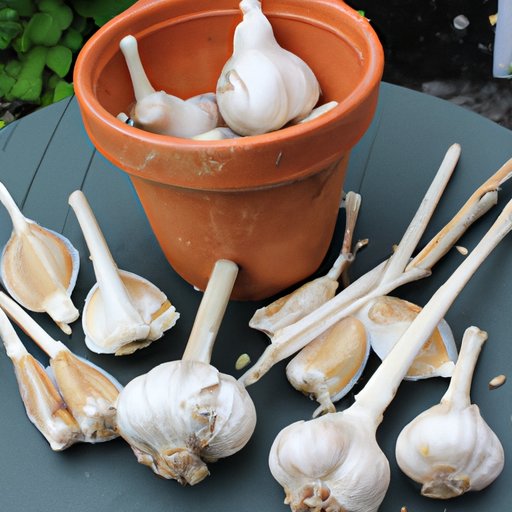
Introduction
Garlic is a staple ingredient in many dishes, prized for its unique and pungent flavor. However, buying garlic from the grocery store can sometimes leave you with shriveled and tasteless cloves. As a result, growing garlic from a clove has become a popular trend among home gardeners. Not only can you save money by growing your garlic, but you can also reap the health benefits of fresh and organic garlic. In this article, we will provide you with a detailed step-by-step guide on growing garlic from a clove, as well as explore the health benefits and tips for seasonal and container gardening.
Step-by-Step Guide
To grow garlic from a clove, you need to follow specific steps to ensure a healthy and robust crop.
Choosing a suitable planting location
Garlic thrives in a sunny location with well-draining soil. Therefore, it’s essential to choose a planting location that receives at least six hours of sunlight daily. The soil pH level should be between 6.0 and 7.0, which is slightly acidic. Garlic prefers loose and fertile soil, so avoid planting in heavy clay soil.
Preparing the soil
Prepare the planting soil by loosening it to a depth of at least 10 inches. You can add compost, well-rotted manure, or organic fertilizer to enrich the soil.
Planting the garlic cloves
Break the garlic bulbs into individual cloves and plant them with the pointed side facing up. Plant the garlic cloves 2-3 inches deep and around 6 inches apart.
Watering and fertilizing
Garlic requires consistent moisture throughout its growing season. Water the garlic plants deeply once a week, supplementing with additional watering during hot and dry spells. Fertilize the garlic plants twice, once in the fall and once in the spring, using a high nitrogen fertilizer.
Mulching and weeding
Mulch the garlic plants with organic materials, such as straw or chopped leaves, to help conserve moisture and suppress weeds. Periodically check the planting area for weeds, which can compete with the garlic for nutrients and water.
Harvesting the garlic
Garlic is usually ready for harvesting in late spring or early summer once the leaves have turned brown and started to wilt. Use a garden fork to loosen the soil around the garlic bulbs carefully. Gently lift the garlic bulbs out of the soil and allow them to dry for several weeks.
Health Benefits
Garlic is well-known for its numerous health benefits. It contains a compound called allicin, which has antibacterial, antifungal, and antiviral properties, making it excellent for preventing illness. Additionally, regular garlic consumption has been linked with a reduced risk of heart disease and cancer. Growing garlic at home can ensure that you have a constant source of fresh, organic garlic that contains all its health benefits.
Seasonal Growing
The best time to plant garlic is in the fall, around four to six weeks before the ground freezes. This allows the garlic to develop a strong root system during the winter months. Planting in the spring is also an option, but the garlic bulbs tend to be smaller than those planted in the fall. Additionally, it’s essential to adjust planting times for different climates and regions since garlic plants require a certain number of cold days to grow correctly.
Container Gardening
Container gardening can be an excellent option for growing garlic, especially for those with limited space. Garlic can grow well in a container as long as you keep the following factors in mind:
Choosing the right container
Garlic requires a deep container that provides adequate drainage. A half barrel or large pot is an excellent option for container gardening garlic. It’s also essential to choose a container made of a breathable material like clay or porous plastic to prevent waterlogging.
Selecting the right soil
The container soil should be loose and well-draining. Add perlite or coarse sand to the potting mix to improve drainage.
Planting and caring for garlic in a container
Plant the garlic cloves 2-3 inches deep, with the pointed end facing up. Water the container deeply once a week, supplementing with additional watering during hot and dry spells. Fertilize twice a year, in the fall and spring, with a complete fertilizer. Mulch the container with organic materials to help conserve moisture and suppress weeds.
Harvesting and Storing
To enjoy freshly harvested garlic, you need to ensure proper harvesting and storage.
Best time to harvest garlic
Garlic is ready for harvest when the leaves have turned brown and started to wilt. Harvest the garlic bulbs carefully, making sure not to damage them.
Steps for properly curing garlic
Cure the garlic bulbs by allowing them to dry for a few weeks in a warm, dry, and ventilated area. Once the garlic bulbs are dry, clean them by removing the dirt and excess leaves.
Different storage techniques for preserving garlic
Garlic can be stored whole, peeled, or chopped. Store whole garlic bulbs in a dark and cold location, like a root cellar, for up to 8 months. Store peeled garlic in a sealed container in the fridge for up to 2 weeks. Store chopped garlic in the freezer for up to six months.
Recommend ways to enjoy freshly harvested garlic
Fresh garlic is an excellent ingredient in many dishes. Roast the garlic bulbs and spread the soft roasted garlic on toasted bread or mix it into soups and stews. Alternatively, chop fresh garlic and add it to vinaigrettes, sauces, and marinades.
Conclusion
Growing garlic from a clove is an excellent way to have a constant supply of fresh, organic garlic. We hope that this step-by-step guide and additional tips for seasonal and container gardening can help you grow garlic successfully. Remember to enjoy all the health benefits of garlic and experiment with different storage techniques and recipes.
Don’t hesitate to try growing garlic at home.




